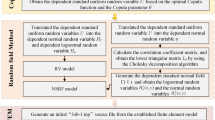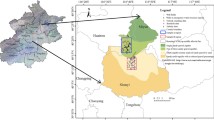Abstract
Conventional landslide analyses, based on deterministic methods or simple random variable methods, cannot consider the spatial variability and the depth-dependent nature of saturated hydraulic conductivity (Ks) in accumulative landslides. However, studies show that these conditions exist objectively and have a large impact on the seepage and deformation of landslides. Thus, the non-stationary characteristics of Ks need to be properly accounted for. In this paper, the Baishuihe landslide is taken as a case study. First, based on surface nuclear magnetic resonance (surface-NMR) technology, spatial variability and the depth-dependent nature of the Ks are obtained. Then, a non-stationary random field model is established to model the trend and fluctuating components of the Ks individually, and a deterministic model is established to model the trend of the Ks with depth. Finally, numerical simulations of the stochastic model and deterministic model under reservoir water fluctuation conditions are carried out by the non-intrusive stochastic finite element method, and the seepage-deformation and stability characteristics of the landslide are analyzed. The results show that compared with that in the deterministic model, the change in pore pressure in the stochastic model obviously lags, during reservoir water drawdown, the displacement of the trailing edge in the stochastic model is larger than that in the deterministic model, with increasing reservoir water deceleration, the hysteresis of the pore pressure in the stochastic model is more notable, and the deformation is larger and the stability is worse in the stochastic model. It is demonstrated that ignoring the spatial variability of the Ks will overestimate the stability of the landslide.























Similar content being viewed by others
References
Baecher GB, Christian JT (2005) Reliability and statistics in geotechnical engineering. Wiley, Hoboken
Behroozmand AA, Keating K, Auken E (2015) A review of the principles and applications of the NMR technique for near-surface characterization. Surv Geophys 36(1):27–85
Cho SE (2014) Probabilistic stability analysis of rainfall-induced landslides considering spatial variability of permeability. Eng Geol 171:11–20
Deutsch CV, Journel AG (1992) Geostatistical software library and user’s guide. New York 119:147
Dou HQ, Han TC, Gong XN, Qiu ZY, Li ZN (2015) Effects of the spatial variability of permeability on rainfall-induced landslides. Eng Geol 192:92–100
El-Ramly H, Morgenstern NR, Cruden DM (2006) Lodalen slide: a probabilistic assessment. Can Geotech J 43(9):956–968
Gong W, Tang H, Wang H, Wang X, Juang CH (2019) Probabilistic analysis and design of stabilizing piles in slope considering stratigraphic uncertainty. Eng Geol 259:105162
Griffiths DV, Fenton GA (1993) Seepage beneath water retaining structures founded on spatially random soil. Geotechnique 43(4):577–587
Griffiths DV, Huang J, Fenton GA (2015) Probabilistic slope stability analysis using RFEM with non-stationary random fields. In: Schweckendiek T, van Tol AF, Pereboom D et al (eds) Geotechnical Safety and Risk V, pp 704–709
Hu XL, Tang HM, Ma SZ, Zhang GC (2006) Numerical simulation of the 3D landslide stability in Three Gorges Area Based on NMR. Earth Sci J China Univ Geosci 31(2):279–284
Huang RQ (2009) Some catastrophic landslides since the twentieth century in the southwest of China. Landslides 6(1):69–81
Huang M, Jia CQ (2009) Strength reduction FEM in stability analysis of soil slopes subjected to transient unsaturated seepage. Comput Geotech 36(1–2):93–101
Huang D, Gu DM, Song YX, Cen DF, Zeng B (2018) Towards a complete understanding of the triggering mechanism of a large reactivated landslide in the Three Gorges Reservoir. Eng Geol 238:36–51
Hügel HM, Henke S, Kinzler S (2008) High-performance Abaqus simulations in soil mechanics. In: Proceedings of Abaqus users conference, pp 192–205
Jiang SH, Huang J (2018) Modeling of non-stationary random field of undrained shear strength of soil for slope reliability analysis. Soils Found 58(1):185–198
Jiang SH, Li DQ, Zhang LM, Zhou CB (2014) Slope reliability analysis considering spatially variable shear strength parameters using a non-intrusive stochastic finite element method. Eng Geol 168:120–128
Juang CH, Zhang J, Shen M, Hu J (2018) Probabilistic methods for unified treatment of geotechnical and geological uncertainties in a geotechnical analysis. Eng Geol 249:148–161
Kitanidis PK (1997) Introduction to geostatistics: applications in hydrogeology. Cambridge University Press, Cambridge
Knight R, Walsh DO, Butler JJ Jr, Grunewald E, Liu G, Parsekian AD et al (2016) NMR logging to estimate hydraulic conductivity in unconsolidated aquifers. Groundwater 54(1):104–114
Lam L, Fredlund DG, Barbour SL (1987) Transient seepage model for saturated–unsaturated soil systems: a geotechnical engineering approach. Can Geotech J 24(4):565–580
Li DY, Yin K, Leo C (2010) Analysis of Baishuihe landslide influenced by the effects of reservoir water and rainfall. Environ Earth Sci 60(4):677–687
Li DQ, Chen Y, Lu W, Zhou C (2011) Stochastic response surface method for reliability analysis of rock slopes involving correlated non-normal variables. Comput Geotech 38(1):58–68
Li C, Tang H, Ge Y, Hu X, Wang L (2014a) Application of back-propagation neural network on bank destruction forecasting for accumulative landslides in the three Gorges Reservoir Region, China. Stoch Env Res Risk Assess 28(6):1465–1477
Li DQ, Qi XH, Phoon KK, Zhang LM, Zhou CB (2014b) Effect of spatially variable shear strength parameters with linearly increasing mean trend on reliability of infinite slopes. Struct Saf 49:45–55
Li DQ, Jiang SH, Cao ZJ, Zhou W, Zhou CB, Zhang LM (2015) A multiple response-surface method for slope reliability analysis considering spatial variability of soil properties. Eng Geol 187:60–72
Liu WP, Zhang LM, Zheng YR, Li X (2009) Investigation of shear strength and permeability parameters for landslide soils in the Chongqing Section of the Three Gorge Reservoir Area. Chin J Undergr Sp Eng 5(1):45–49
Lumb P (1966) The variability of natural soils. Can Geotech J 3(2):74–97
Matheron G (1963) Principles of geostatistics. Econ Geol 58(8):1246–1266
Matheron G (1970) Random functions and their application in geology. In: Merriam DF (eds) Geostatistics. Computer Applications in the Earth Sciences. Springer, Boston, MA
Melchers RE, Beck AT (2018) Structural reliability analysis and prediction. Wiley, Hoboken
Miao F, Wu Y, Xie Y, Yu F, Peng L (2017) Research on progressive failure process of Baishuihe landslide based on Monte Carlo model. Stoch Env Res Risk Assess 31(7):1683–1696
Miao F, Wu Y, Li L, Tang H, Li Y (2018a) Centrifuge model test on the retrogressive landslide subjected to reservoir water level fluctuation. Eng Geol 245:169–179
Miao F, Wu Y, Xie Y, Li Y (2018b) Prediction of landslide displacement with step-like behavior based on multialgorithm optimization and a support vector regression model. Landslides 15(3):475–488
Onyejekwe S, Kang X, Ge L (2016) Evaluation of the scale of fluctuation of geotechnical parameters by autocorrelation function and semivariogram function. Eng Geol 214:43–49
Phoon KK, Kulhawy FH (1999) Characterization of geotechnical variability. Can Geotech J 36(4):612–624
Santoso AM, Phoon KK, Quek ST (2011) Effects of soil spatial variability on rainfall-induced landslides. Comput Struct 89(11–12):893–900
Song K, Wang F, Yi Q, Lu S (2018) Landslide deformation behavior influenced by water level fluctuations of the Three Gorges Reservoir (China). Eng Geol 247:58–68
Springman SM, Jommi C, Teysseire P (2003) Instabilities on moraine slopes induced by loss of suction: a case history. Géotechnique 53(1):3–10
Srivastava A, Babu GLS (2009) Effect of soil variability on the bearing capacity of clay and in slope stability problems. Eng Geol 108(1–2):142–152
Srivastava A, Babu GS, Haldar S (2010) Influence of spatial variability of permeability property on steady state seepage flow and slope stability analysis. Eng Geol 110(3–4):93–101
Tan X, Hu M, Juang CH, Li P, Shen M (2018) Evaluation of the auto-correlation distance of unsaturated soils. In: GeoShanghai international conference. Springer, Singapore, pp 139–146
Van Genuchten MT (1980) A closed-form equation for predicting the hydraulic conductivity of unsaturated soils 1. Soil Sci Soc Am J 44(5):892–898
Vanmarcke EH (1977) Probabilistic modeling of soil profiles. J Geotech Eng Div 103(11):1227–1246
Vanmarcke EH (2010) Random fields: analysis and synthesis (revised and expanded), new ed. World Scientific Publishing Co., Pte. Ltd., Singapore
Wu Y, Cong C, Gaofeng H, Qiuxia Z (2014) Landslide stability analysis based on random-fuzzy reliability: taking Liangshuijing landslide as a case. Stoch Env Res Risk Assess 28(7):1723–1732
Yang HQ, Zhang L, Xue J, Zhang J, Li X (2019) Unsaturated soil slope characterization with Karhunen–Loève and polynomial chaos via Bayesian approach. Eng Comput 35(1):337–350
Zhang J, Xu Q, Chen Z (2001) Seepage analysis based on the unified unsaturated soil theory. Mech Res Commun 28(1):107–112
Zheng YR, Zhao SY (2004) Application of strength reduction FEM in soil and rock slope. Chin J Rock Mechan Eng 23(19):3381–3388
Acknowledgements
This research is supported by the National Natural Science Foundation of China (Grant No. 41977244, Grant No. 41572278), the National Key Research and Development Program of China (Grant No. 2017YFC1501301) and the Guizhou Science and Technology Cooperation Plan (Qian Ke He LH zi [2015]7026). The authors are grateful to the colleagues in our laboratory for their constructive comments and assistance.
Author information
Authors and Affiliations
Corresponding author
Additional information
Publisher's Note
Springer Nature remains neutral with regard to jurisdictional claims in published maps and institutional affiliations.
Rights and permissions
About this article
Cite this article
Xue, Y., Wu, Y., Miao, F. et al. Effect of spatially variable saturated hydraulic conductivity with non-stationary characteristics on the stability of reservoir landslides. Stoch Environ Res Risk Assess 34, 311–329 (2020). https://doi.org/10.1007/s00477-020-01777-1
Published:
Issue Date:
DOI: https://doi.org/10.1007/s00477-020-01777-1




